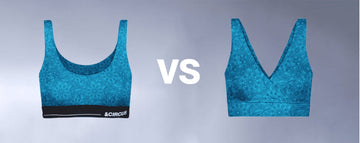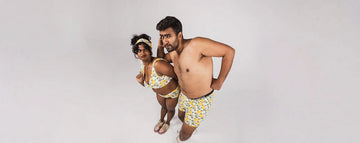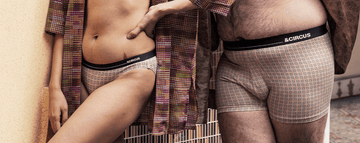In a small Brooklyn boutique, a rack of whisper-soft underwear made from organic cotton and bamboo catches the light. Shoppers pause, running their fingers over the fabric, intrigued by a tag that reads “compostable.” This isn't just a trend it's a quiet revolution. Across the globe, eco-conscious consumers, grassroots collectives, and sustainability advocates are pushing the fashion industry to rethink its reliance on synthetic textiles. Their demand? Fabrics that don't just look good but can return to the earth without a trace. The movement for biodegradable textiles, particularly in intimate wear, is gaining momentum, and it's reshaping how we think about what we wear closest to our skin.
Uncomfortable underwear shouldn't steal your confidence. At Andcircus, we craft ultra-soft, sustainable Lenzing Modal Micro® innerwear for every body, XS to 5XL. From briefs to bras, our custom packs fit you perfectly. Shop risk-free with our 100% satisfaction guarantee and embrace comfort that includes everyone. #LoveEveryBody. Shop Now!
From Niche to Necessity in Sustainable Fashion
The fashion industry, long criticized for its environmental footprint, is under pressure to clean up its act. According to Wikipedia's entry on textile recycling, the process involves recovering fiber, yarn, or fabric and reprocessing it into new products. This shift is driven by necessity: textile waste is a growing problem, split into pre-consumer and post-consumer categories, with a pyramid model sorting it into five types. While recycling both mechanical and chemical offers solutions, biodegradable fabrics are stealing the spotlight. Materials like organic cotton, Tencel™, and micromodal are becoming go-to choices for sustainable innerwear brands, offering softness with a side of eco-virtue.
The numbers tell a compelling story. The global textile market, valued at $1,976.84 billion in 2024, is projected to reach $4,016.50 billion by 2034, growing at a compound annual growth rate (CAGR) of 7.35%, as reported by Precedence Research. Meanwhile, the biodegradable fabrics market is on an even steeper trajectory, expected to soar from $5.22 billion in 2024 to $19.55 billion by 2035, at a CAGR of 12.75%, according to Spherical Insights. These fabrics, made from organic, renewable materials like cotton, wool, silk, and cellulose, decompose naturally, reducing landfill waste. In a world choking on polyester, this is no small feat.
Brands and Communities Leading the Charge
Walk into any sustainable fashion forum online, and you'll see hashtags like #WearCompostable trending. Community-led campaigns are amplifying the call for compostable clothing, with influencers and activists urging brands to prioritize closed-loop systems. Take AndCircus, a trailblazing innerwear brand that's embraced biodegradable fabrics like bamboo and organic cotton. Their designs aren't just comfortable they're a statement that fashion can be circular. Other brands are following suit, collaborating with textile innovators to create products that decompose gracefully after use.
In Europe, where the bioplastic textile market holds the largest share, companies like NatureWorks LLC and BASF SE are driving innovation, as noted in a Strategic Market Research report. Valued at $4.8 billion in 2023, this market is expected to hit $10.06 billion by 2030, growing at a CAGR of 9.7%. The apparel segment, particularly sustainable innerwear, dominates this space, fueled by a fashion industry increasingly leaning into eco-friendly materials. Grassroots collectives are also making waves, partnering with brands to promote take-back programs and composting initiatives, ensuring textiles don't linger in landfills.
Challenges: The Unfinished Seam
But the path to a biodegradable future isn't without snags. Producing these fabrics is costly organic cotton and Tencel™ require significant R&D and investment, which can drive up prices. Then there's the issue of consumer misconceptions. Many assume “natural” equals “biodegradable,” but not all natural fibers break down easily without specific conditions. Composting infrastructure is another hurdle. In many regions, facilities to process biodegradable textiles are scarce, leaving even the most eco-friendly garments stranded in landfills.
Brands also face supply chain bottlenecks. Scaling up production of biodegradable fibers to meet growing demand is no small task, especially when competing with cheaper synthetics. Yet, as regulations tighten several countries have introduced laws to curb textile waste, per the Wikipedia entry the industry has little choice but to adapt. The challenge is clear: sustainability isn't just about materials; it's about building systems to support them.
Opportunities: A New Thread for Fashion's Future
For brands willing to invest, the rewards are substantial. Biodegradable fabrics aren't just good for the planet they're good for business. Consumers, especially younger ones, are voting with their wallets, gravitating toward brands that align with their values. A shift to biodegradable textiles can boost brand perception, fostering trust and loyalty. Plus, it's a step toward net-zero goals, reducing reliance on landfills and incinerators. The global push for circular fashion, where products are designed to be reused or decomposed, is gaining traction, with brands launching recycling programs and take-back initiatives to close the loop.
Innovation is thriving. The Hot or Cool Institute's 2022 report, “Unfit, Unfair, Unfashionable,” proposed a “sufficiency” wardrobe of 74 items for two-season climates (or 85 for four seasons), sparking viral challenges like the “Rule of Five,” which encourages consumers to limit clothing purchases to five items a year, as highlighted in a Vogue Business article. The institute's Sufficiency Approach to Fashion and the Environment (SAFE) panel is now engaging policymakers and businesses to align fashion with 1.5-degree climate goals, proving that sustainability and style can coexist.
Stitching a Future with Less Waste
As the fashion industry stands at a crossroads, experts are optimistic but clear-eyed. Textile scientists and sustainability advocates urge brands to prioritize transparency, seeking certifications like GOTS or OEKO-TEX® to validate their claims. Consumer education is equally critical shoppers need to understand what “biodegradable” really means and how to dispose of these garments properly. Most importantly, the movement for biodegradable textiles isn't just about fabric choices; it's about rewriting fashion's narrative, from fast fashion's throwaway culture to a model that respects the planet.
Back in that Brooklyn boutique, a customer slips a pair of compostable underwear into their bag, a small act that feels like a vote for change. Community voices amplified by social media, NGOs, and everyday shoppers are weaving a new story for fashion. It's one where waste isn't an afterthought but a problem solved from the first stitch. As biodegradable fabrics move from niche to mainstream, they're not just changing what we wear they're redefining what fashion can be.
Frequently Asked Questions
Why are communities advocating for biodegradable textiles in fashion?
Communities are pushing for biodegradable textiles because they offer a sustainable alternative to synthetic fabrics that contribute to long-term pollution. These materials break down naturally, reducing landfill waste and microplastic pollution, aligning with environmental goals and consumer demand for eco-conscious apparel.
What are the benefits of using biodegradable fabrics in innerwear and lingerie?
Biodegradable fabrics provide comfort, breathability, and skin-friendliness ideal for sensitive areas like those covered by innerwear and lingerie. Beyond personal comfort, they support sustainability by minimizing environmental impact at the end of their life cycle.
How do biodegradable textiles impact the fashion industry and consumer behavior?
Biodegradable textiles are reshaping the fashion industry by prompting brands to innovate with sustainable materials and transparent production practices. For consumers, the growing awareness around environmental responsibility is influencing purchasing decisions toward more planet-friendly options.
Disclaimer: The above helpful resources content contains personal opinions and experiences. The information provided is for general knowledge and does not constitute professional advice.
You may also be interested in: Inside the Craft of Creating Bras for All Body Types
Uncomfortable underwear shouldn't steal your confidence. At Andcircus, we craft ultra-soft, sustainable Lenzing Modal Micro® innerwear for every body, XS to 5XL. From briefs to bras, our custom packs fit you perfectly. Shop risk-free with our 100% satisfaction guarantee and embrace comfort that includes everyone. #LoveEveryBody. Shop Now!







































